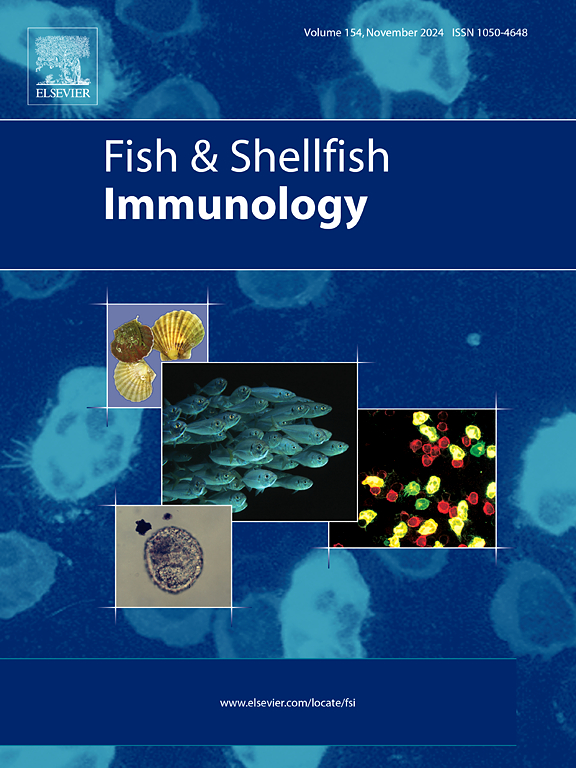MALT1通过激活NF-κB信号,增强中华绒螯蟹血细胞吞噬能力,促进抗菌免疫应答。
IF 4.1
2区 农林科学
Q1 FISHERIES
引用次数: 0
摘要
粘膜相关淋巴组织淋巴瘤易位蛋白1 (MALT1)是一种支架蛋白,在t细胞受体(TCRs)和b细胞受体(BCRs)下游的NF-κB通路中起关键作用。作为一个关键的信号中枢,MALT1整合了多种途径,使其对先天免疫和适应性免疫都至关重要。然而,其在甲壳类动物的抗菌免疫反应中的作用尚不清楚。本文对中华绒螯蟹(Eriocheir sinensis)的MALT1进行了鉴定,记为EsMALT1,并将其序列和结构域保守性与其他物种的MALT1进行了比较。此外,副溶血性弧菌感染显著上调了EsMALT1的表达。血细胞中敲低EsMALT1可抑制NF-κ b样转录因子esspit和EsDorsal在副溶血性弧菌刺激下从细胞质向细胞核的易位,从而降低抗菌肽抗脂多糖因子(anti- lipopolyaccharide factor, ALF)和甲壳蛋白的表达。在细胞水平上,沉默EsMALT1表达可显著抑制螃蟹血细胞对副溶血性弧菌的吞噬能力。在体内,沉默EsMALT1使螃蟹易受细菌感染,并削弱其细菌清除能力。综上所述,EsMALT1可促进中华赤霉素的体液免疫和细胞免疫,对诱导抗菌免疫应答至关重要。本文章由计算机程序翻译,如有差异,请以英文原文为准。
MALT1 promotes the antibacterial immune response by activating NF-κB signaling and enhancing hemocyte phagocytosis in the Chinese mitten crab
Mucosa-associated lymphoid tissue lymphoma translocation protein 1 (MALT1), a scaffold protein, plays a pivotal role in the NF-κB pathway downstream of T-cell receptors (TCRs) and B-cell receptors (BCRs). As a key signaling hub, MALT1 integrates various pathways, making it essential for both innate and adaptive immunity. However, its role in the antibacterial immune responses of crustaceans remains unclear. Here, we characterized MALT1 from the Chinese mitten crab (Eriocheir sinensis), denoted as EsMALT1, and compared its sequence and domain conservation with MALT1 from other species. Furthermore, Vibrio parahaemolyticus infection upregulated EsMALT1 expression markedly. Knockdown of EsMALT1 in hemocytes inhibits the translocation of the NF-κB-like transcription factors EsRelish and EsDorsal from the cytoplasm to the nucleus in response to Vibrio parahaemolyticus stimulation, thereby reducing the expression of the antimicrobial peptides anti-lipopolysaccharide factor (ALF), and Crustins. At the cellular level, silencing of EsMALT1 expression significantly inhibited the phagocytic capacity of crab hemocytes against Vibrio parahaemolyticus. In vivo, silencing of EsMALT1 rendered crabs susceptible to bacterial infection and impaired their bacterial clearance. In conclusion, EsMALT1 promotes both humoral and cellular immunity in E. sinensis, making it essential for the induction of antibacterial immune responses.
求助全文
通过发布文献求助,成功后即可免费获取论文全文。
去求助
来源期刊

Fish & shellfish immunology
农林科学-海洋与淡水生物学
CiteScore
7.50
自引率
19.10%
发文量
750
审稿时长
68 days
期刊介绍:
Fish and Shellfish Immunology rapidly publishes high-quality, peer-refereed contributions in the expanding fields of fish and shellfish immunology. It presents studies on the basic mechanisms of both the specific and non-specific defense systems, the cells, tissues, and humoral factors involved, their dependence on environmental and intrinsic factors, response to pathogens, response to vaccination, and applied studies on the development of specific vaccines for use in the aquaculture industry.
 求助内容:
求助内容: 应助结果提醒方式:
应助结果提醒方式:


